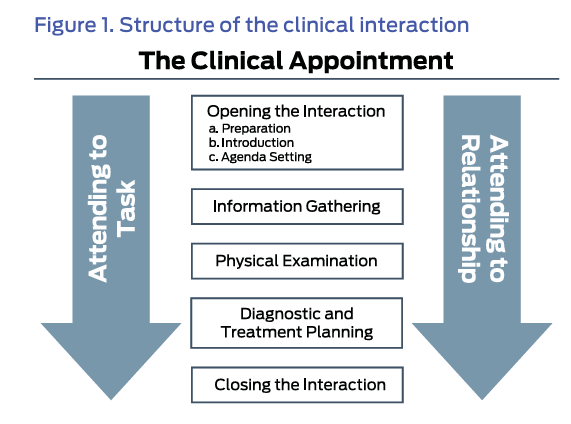
Communication Skills for Owner Adherence
Lisa J. Hunter
MSW
Colorado State University
Fort Collins, Colorado, USA

Jane R. Shaw
DVM, PhD
Colorado State University
Fort Collins, Colorado, USA
Begin With the End in Mind
The opening of the appointment consists of three communication steps: preparation, introduction, and agenda setting (Figure 1).1 The next step in the visit is information gathering. So, before jumping into getting a history, elicit the client’s agenda in every appointment, every time.

What Is Agenda Setting?
Agenda setting is a transformative communication process that potentiates client satisfaction, adherence to recommendations, and appointment efficiency.1 The agenda allows the pet caregiver and the veterinary health care team to set mutual expectations for the remainder of the appointment [satisfaction]. It lays the groundwork for the diagnostic, treatment, and care plan by identifying the client’s goals and expectations [adherence]. Employing agenda setting early demonstrates the veterinary team’s interest and investment in meeting the client’s needs [satisfaction and adherence]. Cocreating a mutual agenda with the client provides a framework for the visit and lays out the topics for exploration and discussion [efficiency].
Agenda setting involves more than what brought the client and patient into the hospital. Agenda setting is a six-step, systematic, and structured question-asking process utilizing two communication skills: open-ended inquiry, to elicit the agenda items, and summary, to ensure thoroughness:
- Reasons for the visit—What brings you and Francis in today?
- Client’s concerns—What concerns do you have for Francis?
- Goals and expectations—How can we work with you and Francis to meet your needs?
- Summary—Let me recap. You noticed increased itching, licking, and redness under his tail and multiple bouts of soft stool after a recent dietary change [reasons]. We need to be gentle as Francis is sensitive to touch in that area [concerns]. You hope that we can figure out what’s going on and make Francis more comfortable [goals and expectations] [summary].
- Check-in—What else can we address for you today?
- Priorities—Of all that you shared with me, what is most important to you?
Use open-ended inquiry to draw out why the client scheduled the appointment, their worries, and what they would like to accomplish. Summarize the list to ensure accuracy and check in again for any remaining agenda items to develop a complete inventory.1 The final step in agenda setting is to identify the client’s priorities to ascertain where to start and how to best spend the appointment time.
What Is the Benefit of Agenda Setting?
Agenda setting is the first step to offer contextualized care, where veterinary professionals tailor the diagnostic and/or treatment plans to the patient and client needs.2 An individualized approach overcomes barriers to care, including financial, lifestyle, and schedule concerns, enhancing caregiver adherence.3 When the diagnostic, treatment, and care plan align with the client’s reasons for the visit, concerns for their pet and their goals, expectations, and priorities, clients are more likely to adhere to the recommendations. When clients are invited to share what is important to them, they feel heard by the veterinary health care team, and their needs are met, they leave the visit satisfied and empowered to enact the plan of care.
Key Points
To enhance the caregiver’s adherence to veterinary recommendations:
- Obtain the client’s agenda upfront, every appointment, every time.
- Follow a structured and methodical agenda-setting process.
- Align with and tailor recommendations to the client’s agenda to overcome barriers to care.
Related Tools and Content:
Nutrition Conversation Tips and Tricks
Successful nutrition conversations start with an agenda everyone agrees upon.
Using Open-Ended Questions to Elicit Accurate Nutrition Information
Getting accurate information is the first step toward creating a solid nutrition plan.
Addressing Communication Challenges With Clients
Learn why effective communication about pet nutrition is essential for improving pet health outcomes, building client trust, and fostering collaboration between pet owners and veterinary health care teams.
References
- Shaw, J. R., & Coe, J. B. (2024). Developing communication skills for veterinary practice. John Wiley & Sons, Inc.
- Englar, R. E. (2023). Recasting the gold standard – part I of II: Delineating healthcare options across a continuum of care. Journal of Feline Medicine and Surgery, 25(12), 1-11. doi: 10.1177/1098612X231209855
- Brown, C. R., Garrett, L. D., Gilles, W. K., et al. (2021). Spectrum of care: More than treatment options. Journal of the American Veterinary Medical Association, 259(7), 712-717. doi: 10.2460/javma.259.7.71